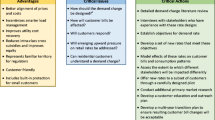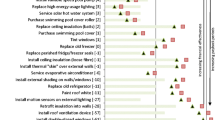Abstract
The electricity rate reforms proposed in the Public Utility Regulatory Policies Act reflect the quest for an energy policy which encourages conservation, efficiency, and equity. Focusing on equity concerns, this research examines the relative effectiveness of lifeline and time-of-day rates in easing the burden of rising household energy prices among the low-income population. Lifeline rates establish a minimum number of kilowatt hours (kWh) required for basic necessities and a special low rate for these kWh. Time-of-day rates provide lower electricity prices to those households using electricity during off-peak generating hours. The data indicate that lifeline rates would assist low-income households in general, with the greatest benefits going to poor households with small numbers of members and older heads of household. Time-of-day rates would immediately benefit smaller households and those with older household heads. Some lifestyle changes, in the form of appliance use patterns, would be required among the low-income population if they are to benefit from time-of-day rates.
Similar content being viewed by others
References
Alperovitz, G. (1979). “Energy and inflation: the broad view,” in E. Cose (ed.), Energy and Equity: Some Social Concerns. Washington, D.C.: Joint Center for Political Studies.
Barbour, I., H. Brooks, S. Lakoff, and J. Opie (1982). Energy and American Values. New York: Praeger.
Burgess, G. and M. Paglin (1981). “Lifeline electricity rates as an income transfer device,” Land Economics 57:41–47.
Cicchetti, C. and M. Reinbergs (1979). “Electricity and natural gas rate issues,” Annual Review of Energy 4:231–258.
Congressional Quaterly, Inc. (1981). Energy Policy. Washington, D.C.: Congressional Quaterly, Inc.
Cullen, B., J. Johnson, and L. Sommers (1983). “Implications of electric utility rate reform legislation for low-income households in Oakland and Livingston counties, Michigan,” The Social Science Journal 20:87–97.
Cunningham, W. and S. Lopreato (1977). Energy Use and Conservation Incentives. New York: Praeger.
Dahl, A. (1978). “California's lifeline policy,” Public Utilities Fortnightly 102:13–22.
Dillman, E., E. Rosa, and J. Dillman (1983). “Lifestyle and home energy conservation in the United States: the poor accept lifestyle cutbacks while the wealthy invest in conservation,” Journal of Economic Psychology 3:299–315.
Duncan, G. (1984). Years of Poverty, Years of Plenty. Ann Arbor, MI: The University of Michigan, Institute for Social Research.
Electric Utility Executives' Forum (1977). “Utility service for everyone,” Public Utilities Fornightly 100:79–82.
Frank, R. (1977). “Lifeline proposals and economic efficiency requirements.” Public Utilities Fortnightly 99:11–15.
Gallavan, W. (1978). “Lifeline electric rates in California: one utility's experience,” in H. Trebing (ed.), Assessing New Pricing Concepts in Public Utilities. East Lansing, MI: Michigan State University Press.
Heberlein, T., D. Linz, and B. Ortiz (1982). “Satisfaction, commitment, and knowledge of customers on a mandatory participation time-of-day electricity pricing experiment,” Journal of Consumer Research 9:106–114.
Henderson, L. (1979). “Energy policy and social equity,” in R. Lawrence (ed.), New Dimensions to Energy Policy. Lexington, MA: D.C. Heath and Company.
Landsberg, H. and J. Dukert (1981). High Energy Costs: Uneven, Unfair, Unavoidable? Baltimore, MD: Johns Hopkins University Press.
Miedam, A. (1980). “Overview of Department of Energy analyses of residential time-of-use data,” paper presented at Electric Rate Demonstration Conference. Denver, CO.
Morrison, D. (1978). “Equity impacts of some major energy alternatives,” in S. Warkov (ed.), Energy Policy in the United States: Social and Behavioral Dimensions. New York: Praeger.
National Association of Regulatory Utility Commissioners (1982). Second Report on State Commission Progress Under the Public Utility Regulatory Policies Act of 1978. Washington, D.C.
National Energy Policy Plan (1981). Securing America's Energy Future. Washington, D.C.: U.S. Department of Energy.
Newman D. and D. Day (1975). The American Energy Consumer. Cambridge, MA: Ballinger.
Pace, J. (1975). “The poor, the elderly, and the rising cost of energy,” Public Utilities Fortnightly 95:26–30.
Parmesano, H. and C. Martin (1983). “The evolution in U.S. electric rate designs,” Annual Review of Energy 8:45–94.
Perlman, R. and R. Warren (1977). Families in the Energy Crisis: Impacts and Implications for Theory and Policy. Cambridge, MA: Ballinger.
Reagan, M. (1983). “Energy: government policy or market result?” Policy Studies Journal 11:365–385.
Scott, F. (1981). “Estimating recipient benefits and waste from lifeline electricity rates,” Land Economics 57:537–543.
Sharkey, D. (1982). “Lifeline rates,” Electric Ratemaking 1:83–84.
Simon, J. (1969). Basic Research Methods in Social Science. New York: Random House.
Smartt, L. (1982a). “Review of current cases,” Public Utilities Fortnightly 109:67–68.
Smartt, L. (1982b). “Lifeline rates rejected,” Public Utilities Fortnightly 110:57–58.
Smith, J. and M. York (1978). “Socio-economic impact of peak load pricing rates,” in R. Hill (ed.), Energy Technology 5: Challenges to Technology. Washington, D.C.: Government Institutes, Inc.
Sullivan, T. (1979). The Los Angeles Senior Citizens Lifeline Electricity Rate. Rand Monograph (R-2278-DWP/NSF).
United States Supreme Court (1978). Memphis Light, Gas and Water Division v Craft. United States Reports 436:1–30.
Author information
Authors and Affiliations
Additional information
This research was supported by a Department of Energy grant from the Oklahoma Corporation Commission (DE-FG-01-79 RG 10220) to the National Energy Law and Policy Institute at the University of Tulsa.
Rights and permissions
About this article
Cite this article
Blocker, T.J. Reforming electricity rates: Benefits to low-income households. Popul Res Policy Rev 4, 67–84 (1985). https://doi.org/10.1007/BF00125542
Issue Date:
DOI: https://doi.org/10.1007/BF00125542




